Volkswagen Tiguan Service and Repair Manual: Wheel, Balancing
Wheel, Balancing on Stationary Balancing Machine
Before beginning balancing, the following requirements must be fulfilled.
- The tire pressure must be OK.
- The tire profile must not be worn on one side. The tire profile must be at least 4 mm.
- The tires must not have any damage such as cuts, holes, foreign bodies, etc.
- The suspension and steering, including the shock absorber, must be in perfect condition.
- Test drive performed.
Note
- If equipped handle the glued-on wheel trim carefully. Surface slightly scratched.
- Replace the damaged rim wheel trim.
- Use only the Model-Specific Clamping Plate VAS6652 -VAS6652- and the Thrust Pin -VAS6652/1-.
Tension Wheel on Balancing Machine
Dirt and rust in the area of the contact surfaces and centering of the wheel distort the result.
- Clean contact surfaces, centering seat and wheel disc using the Pneumatic Brush Grinder Set -VAS6446- before tensioning wheel on balancing machine! Refer to Workshop Equipment, Catalog.
Note
The wheel balancing machine must use the correct system for centering and tensioning the tires when replacing them Reference the information for the Wheel Balancing Machine Centering System before beginning any work. Refer to Workshop Equipment, Catalog.
- Tension the wheel with the tire on the balancing machine.
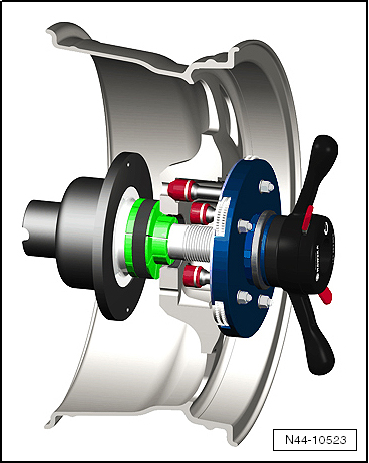
Note
- To mount wheel on wheel balancer, use for example Wheel Centering System Adapter -VAS5271-.
- This way a 100% centering of the wheel and gentle mounting is possible!
- It is not possible to center it 100% on balancing machine with conical tensioners.
- With a deviation of 0.1 mm outside the center, there is an imbalance of 10 grams on the wheel/tire.
Wheel/Tire Balancing Procedure
- Let the wheel/tire turn on the balancing machine.
- Check the run of the characteristic lines on the sidewall of the tire in the area of the rim flange.
- Check the tire wear pattern while the wheel/tire is turning.
Note
In the event of one-sided wear, flat spots from braking or severe wear spots, smooth running cannot be achieved by balancing. In this case, the tire must be replaced.
- Check the run-out on the wheel/tire. If the wheel with tire runs untrue although there are no flat spots, a radial or lateral run-out may be the cause.
- Check wheel with tire for radial- and lateral run-out.
- If the radial and lateral run-out are within the specified tolerance, balance the wheel and tire.
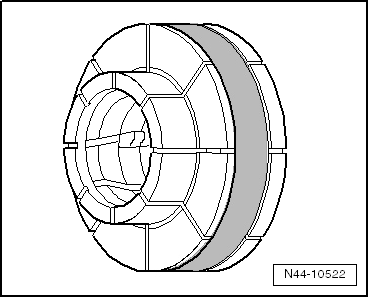
Note
- Do not use more than 60 grams of weight per wheel.
- If more weight is necessary, a smoother running can achieved by matched mounting of the tire. Matching a tire.
- The display in the balancing machine should show 0 grams.
- Hunter RFT33VAG Road Force Touch Wheel Balancer -VAS6230B4- can be inserted as an alternative to matching.
Install the wheel on the vehicle.
Caution
If brake pads are ceramics, wheel must not fall on brake rotor, otherwise it will be destroyed. To remove/install wheel, install long assembly pin instead of wheel bolts in top position (12:00 position) and short assembly pin in wheel bolt mounts for support. In this way, the wheel can glide on the assembly aids when removing/installing.
- Tighten the lowest wheel bolt by hand to approximately 30 Nm.
- Tighten the remaining wheel bolts diagonally to approximately 30 Nm. This process centers the wheel on the wheel hub.
- Lower the vehicle onto its wheels.
- Use a torque wrench to tighten the wheel bolts diagonally to the specified tightening specification.
- Perform a road test.
If a vibration is still detected during the road test, the cause may be due to tolerance in the wheel centering.
The component tolerances of wheels and wheel hubs can be additive in unfavorable cases. Vibration can result from this. This can be eliminated using a finish balancer.
Wheel, Balancing with Fine Balancing Machine (Finish Balancer)
Before beginning balancing, the following requirements must be fulfilled.
- The tire pressure must be OK.
- The tire profile must not be worn on one side. The tire profile must be at least 4 mm.
- The tires must not have any damage such as cuts, holes, foreign bodies, etc.
- The suspension and steering, including the shock absorber, must be in perfect condition.
- Test drive performed.
Note
- If equipped handle the glued-on wheel trim carefully. Surface slightly scratched.
- Replace the damaged rim wheel trim.
- Use only the Model-Specific Clamping Plate -VAS6652- and the Thrust Pin -VAS6652/1-.
Note
- Working with a Finish Balancer requires instruction from the manufacturer of the balancer.
- When balancing, place the wheels of the driven axle on the turntable sensors. On a FWD vehicle, the front wheels must be on the sensors. On AWD vehicles, all 4 wheels must be on the sensors.
If it is determined when balancing on the vehicle the remaining imbalance is more than 20 grams, the wheel should be rotated on the wheel hub.
- Mark the point at which the imbalance is indicated.
- Afterwards, unbolt the wheel and rotate its position on the wheel hub so that the marking points downward.
Note
The wheel hub must not turn during this procedure.
- First, tighten the lowest wheel bolt hand-tight to approximately 30 Nm.
- Tighten the remaining wheel bolts diagonally to approximately 30 Nm. This process centers the wheel properly on the wheel hub.
- Check again whether the imbalance is less than 20 grams using the finish balancer.
Note
The imbalance should not be smaller than 20 grams under any circumstances before changing balance weight.
- Loosen the wheel bolts again, if necessary.
- Rotate the wheel relative to the wheel hub once more by one or two wheel bolt holes.
- Tighten the wheels according to the method described above.
Note
Only if the imbalance is less than 20 grams should the imbalance be reduced by changing the balance weight.
- Balance the wheels until the imbalance is below 5 grams.
- Tighten the wheel bolts to the specified tightening specification if you have not already done so.
Always Tighten the Wheel Bolt to the Tightening Specification and Using the Torque Wrench.
Wheel, Balancing, Tire and Wheel Radial and Lateral Run-Out, Checking
Before beginning balancing, the following requirements must be fulfilled.
- The tire pressure must be OK.
- The tire profile must not be worn on one side. The tire profile must be at least 4 mm.
- The tires must not have any damage such as cuts, holes, foreign bodies, etc.
- The suspension and steering, including the shock absorber, must be in perfect condition.
- Test drive performed.
Radial and lateral run-out occur when the wheel and tire are not running precisely true.
For technical reasons, 100% true running is not possible.
Therefore the manufacturers of these components allow a precisely specified tolerance.
Mounting the tire in a unfavorable position on the wheel can be the cause for exceeding the maximum allowed tolerance for wheel with tire.
Checking Lateral Run-Out
- Preload the Tire Dial Gauge approximately 2 mm.
- Position the Tire Dial Gauge on the side wall of the tire.
- Rotate the wheel slowly.
- Note the smallest and the largest dial readings.
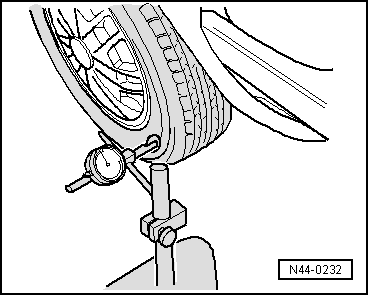
Note
If the difference is greater than 1.3 mm, the lateral run-out is too great.
In this case the radial run-out can be reduced by matched mounting.
Peak values on the Tire Dial Gauge due to small irregularities in the rubber may be disregarded.
Checking Radial Run-Out
- Preload the Tire Dial Gauge approximately 2 mm.
- Position the Tire Dial Gauge on the tread of the tire.
- Rotate the wheel slowly.
- Note the smallest and the largest dial readings.
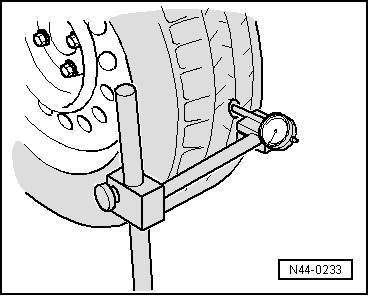
Note
If the difference is greater than 1 mm, the radial run-out is too great.
In this case the radial run-out can be reduced by matched mounting.
The table shows the maximum permissible tolerance values for the wheel with mounted tire.
Tolerances for Radial and Lateral Run-Out of Rim With Tire
| Rim With Tire | Radial Run-Out (mm) | Lateral Run-Out (mm) |
| Passenger Vehicle | 0.9 | 1.1 (1.3 near the lettering) |
Wheel Balancing, Rim Radial and Lateral Run-Out, Checking
- Mount the rim on the Balancing Machine.
- Use the Wheel Centering System Adapter -VAS5271-.
- Preload the Tire Dial Gauge approximately 2 mm.
- Turn the rim slowly.
- Note the smallest and the largest dial readings.
H - Radial Run-Out
- Compare determined value with specifications in the table.
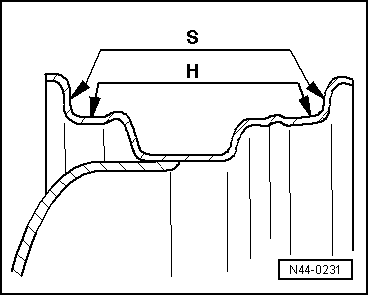
Note
Peak values on the Tire Dial Gauge due to small irregularities may be disregarded.
Specified Values for Radial and Lateral Run-Out on the Rim
| Rim | Radial Run-Out (mm) | Lateral Run-Out (mm) |
| Steel wheel | 0.5 | 0.5 |
| Light alloy wheel | 0.5 | 0.8 |
Note
If the measured value exceeds the specified value, no acceptable smooth running can be attained.
 Tires, Dismounting
Tires, Dismounting
Remove the valve insert.
Note
If equipped handle the glued-on wheel trim carefully. Surface slightly
scratched.
Replace the damaged rim wheel trim.
Place the press-off blade -1- over the t ...
 Wheel, Mounting
Wheel, Mounting
Wheel, Mounting, Volkswagen Assembly Instructions
Vehicles With Tire Pressure Monitoring Sensor.If wheels are changed (for
example, change from summer to winter tires), wheel electronics send data as ...
See More:
Volkswagen Tiguan Service and Repair Manual > Exterior Lights, Switches: Side Marker Lamps
Front Side Marker Lamp
Front Side Marker Lamp, Removing and Installing
Note
Additional information:
Refer to Self Study Program; No 404; The Tiguan.
Refer to
→ Wiring diagrams, Troubleshooting & Component locations
Note
The front bumper cover does not need to be removed when remov ...
Volkswagen Tiguan Owners Manual
Volkswagen Tiguan Service and Repair Manual
- Body exterior
- Body Interior
- General Paint Information
- Paint
- Brake System
- Suspension, Wheels, Steering
- Wheel and Tire Guide
- Towing Guide
- Wheel and Tire Guide General Information
- Communication
- Electrical Equipment General Information
- Electrical Equipment from 06/2011
- Heating, Ventilation and Air Conditioning
- Refrigerant R134a Servicing
- 6-Speed Manual Transmission 02Q, OBB, and OFB
